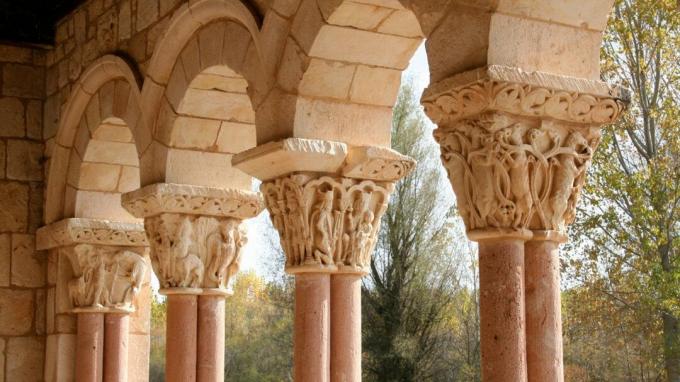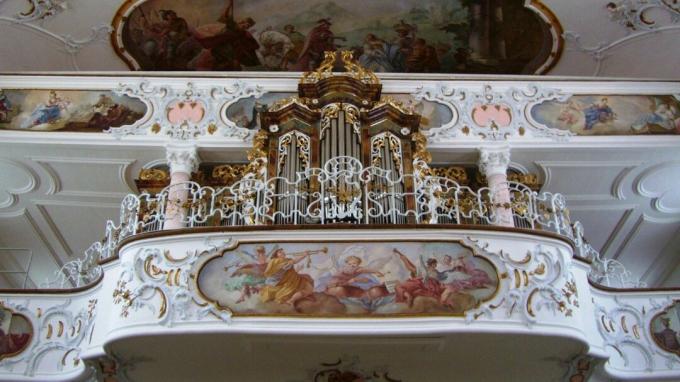The 10 main artistic currents: what are they?
Gombrich said in his great History of Art that art does not exist, only artists. To a certain extent, this is completely true, since each creator expresses from his own world, unique and non-transferable. However, it is no less true that artists cannot escape their time. Each artistic expression, therefore, is subject to a specific context and, no matter how much the artist tries to disassociate himself, he remains subject to it to a greater or lesser degree.
Next, we are going to make a practical summary of what are the main artistic currents in the history of art. This article is just a basic outline; Let's remember that nothing is black or white and that there are a huge number of nuances. All cultures and all times have expressed art in some way.
It is difficult to summarize in such a small article the essential characteristics of all of them, but we will try to give an overview that can be practical when it comes to understanding the evolution of art through history. As a point, say that
We have focused the article on Western art, since it is completely impossible to summarize the universal artistic expression in so little space.. We hope you find it useful.- We recommend you read: "Why was art created? A journey through history"
What is an artistic current?
Artistic currents (also known as artistic movements) are the set of creations that share context and a series of aesthetic characteristics, as well as ideological objectives determined. Following this definition, we could also call the artistic current the art created by the great ancient cultures, such as Egypt, Greece or Mesopotamia.
However, this is not entirely correct. In the aforementioned civilizations there was no other possibility of creation; it was the genuine expression of the culture as a whole, so it is somewhat risky to call it an artistic stream. Therefore, we are going to start our journey from the last centuries of the Middle Ages, when the different cultural movements begin to quickly follow each other to culminate in the mosaic of styles that occurred in the nineteenth century and in the twentieth
1. the romanesque
The Romanesque is perhaps the first fully European style, with some very specific global characteristics.. And, although it is true that it was not as homogeneous a style as other later trends, such as the Baroque or the Romanticism, it is true that in all latitudes of Europe it shares a series of elements that make it more or less a style compact.
The Romanesque appeared around the 11th and 12th centuries in Burgundy; specifically, in the abbey of Cluny. From there it spread to the rest of Europe, where each territory bathed it with its own characteristics. We cannot make a complete analysis of what the Romanesque is, but we can summarize that, architecturally, it includes Roman construction elements (hence the name given to it in the 19th century) and that its bases are the semicircular arch, the barrel vault and the groin vault, among many other elements constructive.
The architectural Romanesque obeys the need for unification of the liturgy in Europe and the appearance of so-called pilgrimage churches, with a very specific structure. In Romanesque buildings, sculpture is usually subordinated to architecture, and we find a greater profusion of sculptural decoration on the eardrums and on the archivolts of the doors.
On the other hand, Romanesque painting draws on Byzantine icons that came from the East with the Crusades, as well as Mozarabic miniatures. They are hieratic paintings, very unrealistic, whose main objective was to convey a message, not copy reality. For this reason, in Romanesque pictorial spaces there is neither perspective nor volume, and earthly elements are mixed with heaven and hell, duly separated by stripes of bright colors.

2. the gothic
The next fully European style was Gothic. Especially uniform was the so-called International Gothic, which developed in the fourteenth century and recovered the Byzantine golden backgrounds with ideally stylized figures. In the Gothic, the representations begin to be imbued with reality, and the figures tend to become more human. It is the time of the cities, of the bustle of commerce, of the great cathedrals. The Gothic Virgins begin to be real mothers, far removed from the Theotokos Virgins or Virgins of the throne, hieratic, who did not interact with the Child. On the other hand, the Crucified, both pictorial and sculptural, become naturalized and begin to show pain.
The most characteristic element of the Gothic are, of course, the cathedrals. The architectural language of these buildings is very novel; Despite this, Giorgio Vasari, in the 16th century, described these constructions as "barbaric" (Gothic). Flying buttresses and buttresses proliferate, designed to give stability to an increasingly tall building with more openings (the marvelous Gothic stained glass windows). It is important to remember that, in the same way as the Romanesque, the Gothic buildings were completely polychrome, a fact that materializes the great love that the Middle Ages felt for chromatic tones lit.
3. The Renaissance
Although classical culture was not forgotten in the Middle Ages, it is during the Renaissance era that it consciously recover the classical precepts, such as the architecture treatises of the Roman Vitruvius (1st century). I a. c.). It is also at this time when the artist is intellectualized, who begins to be seen as something more than a mere craftsman.
The Renaissance begins in Florence at the beginning of the 15th century, with works such as the doors of the Baptistery or the magnificent dome that Brunelleschi designed for the cathedral., whose diameter had not been achieved since the construction of the Pantheon in the first century AD. c. The architects look for inspiration in the constructions of antiquity, while the painters, in the absence of models (Pompeii and Herculaneum had not yet been discovered) are inspired by the frescoes that decorate the Domus Aurea in Nero.
Yet the most important innovation of the Renaissance was mathematical perspective, codified by Leon Battista Alberti (1404-1472) in his treatise De pictura, for which he drew on the ideas of Brunelleschi. From then on, painting will seek to be a window open to the world, where perspective is achieved through a single vanishing point where all the lines converge.
4. Baroque
In the last years of the 16th century, the Renaissance is completely exhausted and, instead, Mannerism appears, which in painting is characterized by an elongation and a stylization of the figures. But at the beginning of the following century a new aesthetic trend began to take over counter-reformation Europe: the Baroque.
It can be said that the Baroque is the child of the Counter-Reformation of the Catholic Church, which needed a vehicle of expression for its faith.. The objective was to keep the faithful in the Roman Church and prevent them from migrating to Lutheranism. Baroque language is, then, a reflection of this will; In painting, emotion is promoted through the depiction of suffering. The bizarre legends of the saints, against which the Protestants preached, are eliminated and the sacred figures are represented with their attributes. Religion is lowered to the people, and biblical characters appear in everyday scenes, whose models are taken directly from reality.
In architecture, it can be said that the Baroque is still very classicist, especially in France. The Palace of Versailles is a great example of this elegant French classicism. On the other hand, and as usually happens in all styles, each territory gives birth to a different Baroque: in the United Provinces, for example, where there is no and to the Catholic Church and where the patrons are the bourgeois of the cities, an intimate painting is developed, whose maximum representative is Johannes Vermeer.
5. rococo
Wrongly treated as an extension of the Baroque, Rococo is a genuine expression of the first half of the 18th century, the Age of Enlightenment. Hand in hand with enlightened philosophers, this style celebrates the sweetness of life, intimacy, home comfort and all that is beautiful in everyday life.
That is why rococo motifs are happy, festive, not at all dramatic: pastoral, bucolic, masquerade, gallant, flirtatious scenes, etc. In one word: the rococo is the joie de vivre, the joy of living, of the wealthy classes of the Old Regime.

6. Neoclassicism
In many ways, Neoclassicism represents a break with the Rococo. Also emerging in France, like its predecessor, this aesthetic current is the perfect expression for the new French Republic: a sober, austere, harmonious and republican style. Neoclassicism is inspired, of course, by classical art. In painting, he has a preference for grandiose and solemn themes, which serve as a model of virtue for the people; great examples of this are the canvases of Jacques-Louis David (1748-1825), the great neoclassical painter. On the other hand, neoclassical architecture is practically an imitation of ancient Greek and Roman temples; one only has to contemplate the Church of the Madeleine in Paris to realize this.
The Neoclassical style lived its zenith during the Napoleonic era, since its Roman and martial aesthetics suited the empire that the Great Corsican had created very well.. After the fall of Napoleon, neoclassical forms became obsolete and, despite the fact that their aesthetics remained very much alive (especially, in architecture) throughout the 19th century, in the first decades of the century the first expressions of the Romanticism.
7. The romanticism
In the history of art it is common for a style to be born in part as a response to the previous style. And, although nothing is black or white and there are many nuances to this statement, we do find evidence of this in cases such as the birth of Romanticism. While Neoclassicism was an apotheosis of the republican, first, and the Roman empire, later, with all the discipline that this implies, Romanticism was born as a vindication of human subjectivity and, therefore, of individual. Art will never again be seen, at least exclusively, as something subject to power; it is the artist who creates, it is his self that gives rise to artistic expression. The authentic creator is against the Academy and all the corseted rules that strangle art.
All the subsequent currents that exalt creative individualism drink from Romanticism: the Pre-Raphaelites, the Symbolists, the Expressionists and, of course, the Surrealists.. In the case of the latter, they explore to the limit the depths of the human psyche, something that the romantic ones a hundred years before when representing dream worlds, terrible, full of specters, tombs and images fruit of the delirium. On the other hand, the romantic current attaches great importance to the homeland and the nation, as long as it is constituted by individuals who decide, and tends to idealize the past of nations and turn it into legend.
8. realism and naturalism
Around 1850, Romanticism begins to expire. It is the time of positivism, of technological advances, of the Second Industrial Revolution. In the cities, factories grow and the miserable people who live in subhuman conditions multiply. It is then that art begins to forget about the ideal worlds proclaimed by the romantics and becomes interested in social problems and conflicts.
Both in the plastic arts and in literature, the recurring theme is social denunciation. Starving workers who leave the factories like ghosts; ragged and dirty children; prostitutes, beggars, laundresses, young people with no future. Realism is committed, then, to social reality..
Later, the growing interest in psychology makes the realist current evolve towards naturalism, which takes objectivity and observation to the limit. The naturalist artist, who in literature is magnificently represented by Émile Zola (1840-1902), sees reality as a research laboratory, where creatures act based on the stimuli of the half. In this highly scientific art, there is therefore no place for subjectivity, much less for beauty itself.
9. The currents of aestheticism
In response to this art that has become science and that ignores the beauty of the world, a series of currents appeared at the end of the 19th century that proclaimed art for art's sake. This is the case of the Pre-Raphaelite brotherhood, decadence, Parnassianism, symbolism and Art Noveau, better known in Hispanic countries as Modernism.
We cannot talk about all these currents here, but we can point out what they have in common: a forceful aversion to positivism, to technological advancement, to factories, to scientific progress as a castrator of beauty. Therefore, all these aesthetic currents will want to return to art as the exclusive creator of beauty.
10. the vanguards
Again, we cannot talk about all the avant-gardes that proliferated during the last years of the 19th century and the first decades of the 20th century, but we will at least try to name them. The official vanguards appear at the beginning of the 20th century. The first of these is considered to be Fauvism, a current that valued color as a means of subjective expression, not as an imitator of reality. After the Fauves, who held their first exhibition in 1905, the avant-garde followed one another so quickly that some of them overlapped: expressionism, futurism, cubism, dadaism, surrealism...
The avant-garde is the main feature of 20th century art. They are a series of movements that go against the established norms, groups of artists with characteristics common ones that come together to form a kind of pictorial school, usually with a basic ideological manifesto. Currently, we live in a new era of individuality that makes artistic currents blur and fragment into a thousand pieces, so we can hardly talk about currents, but about artists. But is it that perhaps, deep down (and as Gombrich said) it has not always been like this?

